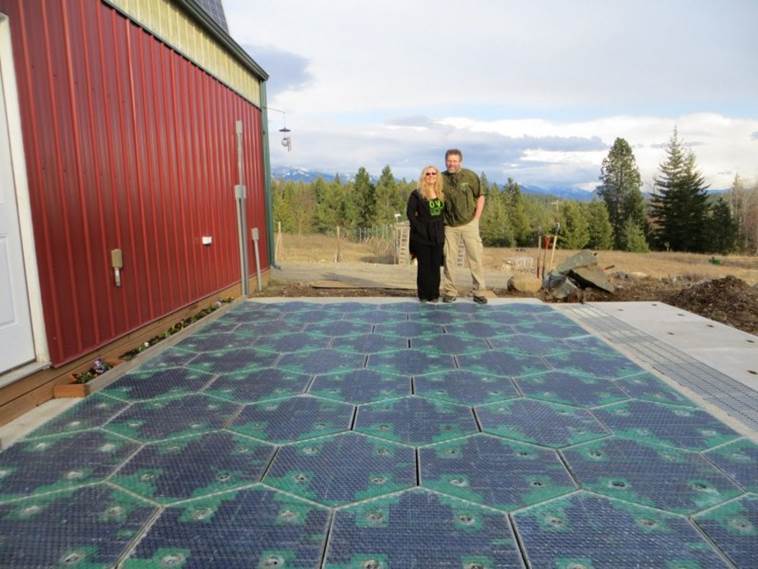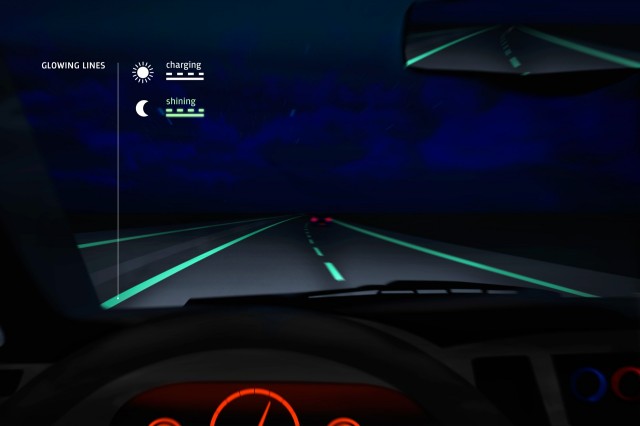
There’s been a lot of talk about solar roadways lately, and since we’ve started to get questions about them, we thought we’d let you know where we stand on the issue.
The idea of using our roads to generate power sounds great, and we’re eager to see how this technology develops, but at this moment, don’t expect to see solar provincial roadways in B.C. anytime soon.
Here’s why.
The concept is still very much being researched and tested. The American Federal Highway Administration (FHWA) funded a test concept brought forward by the company Solar Roadways in 2011. That test was in a parking lot in Sagle, Idaho. It’s now complete, and the company is now looking for funding to move to the next phase of research and testing. A question we’d want answered is how this would stand up to a 26,000 kg logging truck trailer?
Ever heard of glow in the dark highways? It’s another example of the importance of extensive research and testing. Last year, we watched with keen interest as the Dutch government installed this super cool technology on their highway system but, it turned out that after a good stretch of winter in Holland, the technology began to fade… which meant back to the drawing board for more development.

When new products like these are being developed, we have a lot of questions we need answered about this product around functionality, safety, testing, maintainability, life cycles costs and public needs. For example:
- How will it perform on an operational highway?
- How long will it last before it needs to be repaired or replaced?
- How expensive will it be to install, maintain and replace?
- How effective will it be buried under snow for extended periods?
- Could its effectiveness be reduced by the layers of dirt and grime that are common with regular highway use?
- If so, by how much?
There are a lot of other questions that come up as well, but those are some of the big ones we’d need to know the answers to before thinking of using things like this on B.C. highways. The bottom line is we look for products that have met certain government certifications and have a proven track record in the field, and this product hasn’t reached that stage yet.
Even when we know how these products perform on the wide variety of roads and climactic conditions we have in this province, we’d still have to perform a cost-benefit analysis to see if using the technology would be appropriate to use. We do that every time we work on our highways to make sure taxpayers are getting the best value for their money, and if a product costs too much and doesn’t provide enough of a benefit, it doesn’t get used.
Of course, none of this is to say we discourage new technology. In fact, we’re always looking for ways to use new technology, such as sensors for wildlife or beet juice for example, to improve the safety and efficiency of our transportation system. There are many, many innovative ideas being put forward every day and each one is at a different stage of development. Some are at the idea stage, some are more fully developed concepts and other ideas are in the initial field testing stage. Each is a tribute to human ingenuity. Our job is to look at these ideas in terms of our mandate (the safety and mobility of the travelling public in BC), while also being mindful of taxpayers’ dollars. Basically, we need to take a cautious approach and be sure the product is right for our roads.
What are your thoughts about solar roadways or other technologies? Leave us a comment below and let us know.
If you liked this, you might also find these stories interesting:
I live in an area of the province where the much of the hwy is unlit and factoring in weather conditions the nights are very black and difficult to see. Hwy lines are painted with regular paint every few years and they seem to fade quickly. I would like to see lines painted with this reflective paint to see how well it would hold up on Vancouver Island.
Please reconsider a trial period from Parksville to the West Coast.
Thanks for taking the time to comment, Janet. We have shared your response forward. 🙂 Safe travels.
How about forgetting that and replacing the lines with something more durable. The lines now days do not even with stand over one season! Try the counter sunk reflectors and end all this mess of not having anything to drive by…or having to repaint every 6 months. Thanks for listening
Thanks for your comment, Darlene. Line painting in BC has been evolving since oil-based paints were discontinued by federal regulations in 2010, due to concerns around the environment and worker exposure to volatile organic compounds.
We hear a lot of opinions about those old paints, and we understand the nostalgia. However, the fact remains that they’re no longer available to us. So, we’ve been coming up with solutions and honing our approach, to help you stay safely within the lines. Pavement marking now takes place throughout the province at a higher standard than previously. In 2019, new line painting service agreements came into effect, improving on previous contracts, and require:
– 20% more lines painted annually throughout the province;
– larger glass beads in areas for increased reflectivity and visibility at night, and thicker paint for longer-lasting pavement marking;
-second-coat application in areas that experience premature wear; and
-enhanced contractor monitoring and auditing to maintain consistent performance.
Over the years, we’ve been testing and refining paint formulas – looking for a combination that gives us excellent visibility in darkness and low light, with durability, to help motorists to travel where they need to be on the highway. We’ve tested formulations in different climate settings where they perform differently. Finding that “sweet spot” of brightness and durability is a challenge. BC’s mountainous terrain and winter weather is tough on pavement markings. The equipment we use to clear roads of ice and snow, and traction devices like studded tires and tire chains, wear away at line paint. Throw in winter abrasive and salt road treatments, and you’ve got grit that scours pavements markings, when vehicles roll over it Here’s a link to more info: https://www.tranbc.ca/2020/07/23/the-evolving-story-of-brighter-more-durable-line-painting/
Hi M. McGee,
Thanks for your question. The full details of the research were not shared with us. Further investigation and testing is required before we would use this technology in any of our work. We would need to see demonstrated success; analyze how the technology might meet our needs in our climate and terrain; and look at the solar powered roadways from a cost-effective angle.
The question about 26K kg logging trucks is a good one. I am curious what limits and potential opportunities were identified from the testing. Can you say anything about specific test results? Even if solar roadways are not Coquihalla ready, perhaps there may be a shorter-term application on roads with lighter traffic–or the Galloping Goose bike trail?
You could update us more on the beet juice usage. As there are a lot of winter travelers that ask about it.
Hi Connie,
We don’t actually get a lot of questions about it but we’ll certainly share more information as it gets into our winter maintenance program.
Thank you, last winter I had several calls asking why we weren’t using beet juice because the city of Williams Lake was using it last winter.
Here is a blog on beet juice use for you: http://tranbc.ca/2014/02/12/beet-that-the-most-unusual-tool-in-our-winter-snow-fighting-tool-box/
Thanks for posting this, too many people get caught up in the hype without understanding the demands of the transportation network. Keep innovating for effective, sustainable improvements!
One of the most effective advances in road safety in the UK has been the introduction of active reflectors (solar powered LED road studs) marking the centreline and shoulders of each traffic lane. A simple, low cost alternative to high powered street lighting which has brought real benefits in terms of accident reduction on unlit rural highways. These products are used by more than 100 highway authorities in the UK and are capable of withstanding up to 20 ton loads. Most LED studs stand just a few millimetres above the road surface and are unaffected by snow plowing.
http://www.gizmag.com/astucia-solar-powered-road-studs/8382/picture/40104/
Thanks for sharing this with us John. We will share it forward with our engineers to be sure they see it!